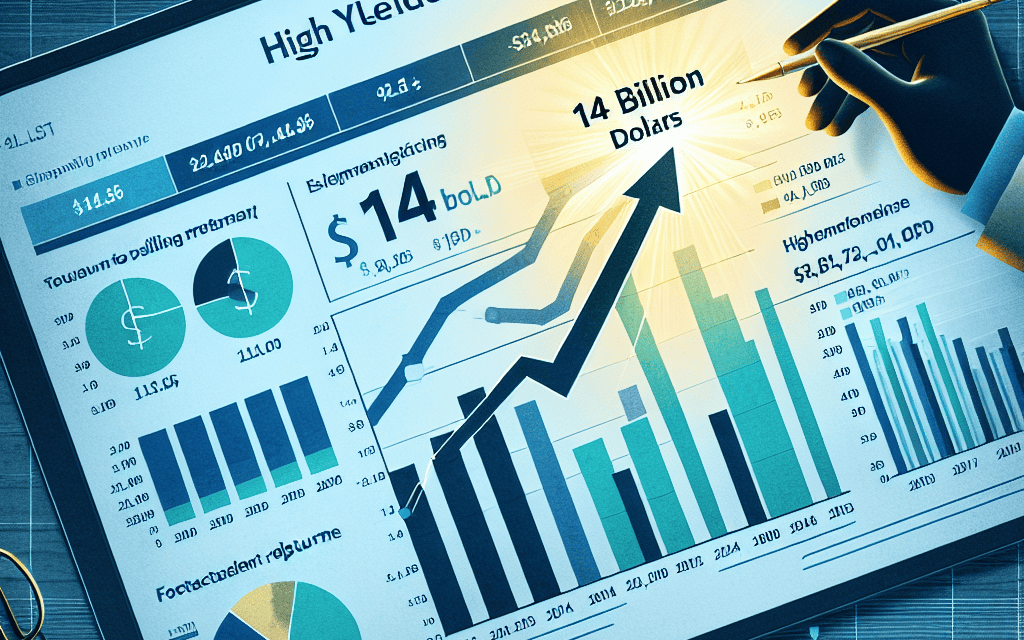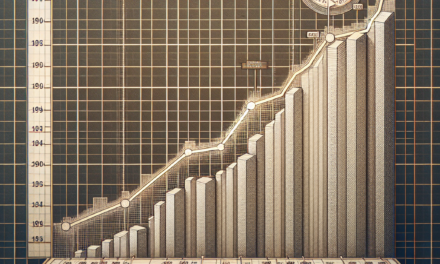“Unlock Wealth: The $14 Billion Stock Surge of 2024!”
Introduction
In the ever-evolving landscape of investment opportunities, one high-yield stock is poised to capture the attention of savvy investors in 2024. This standout company is set to return a staggering $14 billion to its shareholders, marking a significant milestone in its financial strategy. As market dynamics shift and investors seek reliable avenues for growth and income, this stock emerges as a beacon of potential, offering not only robust dividend yields but also a testament to its strong financial health and commitment to shareholder value. With a strategic focus on sustainable growth and profitability, this company is positioned to deliver impressive returns, making it a compelling choice for those looking to enhance their investment portfolios in the coming year.
Understanding High-Yield Stocks: A Guide for Investors
High-yield stocks have long been a cornerstone for investors seeking steady income and potential capital appreciation. These stocks, typically characterized by their above-average dividend yields, offer a compelling proposition for those looking to balance risk and reward in their investment portfolios. As we delve into the intricacies of high-yield stocks, it is essential to understand the factors that contribute to their appeal and the potential risks they may entail. In this context, the announcement of a particular high-yield stock set to return $14 billion to shareholders in 2024 has captured the attention of the investment community, underscoring the significance of these stocks in the broader market landscape.
To begin with, high-yield stocks are often associated with mature companies that generate substantial cash flows, enabling them to distribute a significant portion of their earnings as dividends. This characteristic makes them particularly attractive to income-focused investors, such as retirees, who rely on dividend payments as a source of regular income. Moreover, in a low-interest-rate environment, high-yield stocks can offer a more lucrative alternative to traditional fixed-income investments, such as bonds, which may provide relatively lower returns.
However, it is crucial for investors to conduct thorough due diligence when selecting high-yield stocks, as the promise of high returns often comes with increased risk. Companies offering exceptionally high dividend yields may be doing so because their stock prices have declined due to underlying business challenges. Therefore, investors must assess the sustainability of the dividend payments by examining the company’s financial health, including its earnings stability, debt levels, and cash flow generation. A comprehensive analysis of these factors can help investors discern whether a high-yield stock is a viable long-term investment or a potential value trap.
In light of these considerations, the announcement of a high-yield stock poised to return $14 billion to shareholders in 2024 serves as a testament to the potential rewards of investing in such stocks. This substantial return is indicative of the company’s robust financial performance and its commitment to shareholder value. For investors, this development not only highlights the importance of selecting high-yield stocks with strong fundamentals but also underscores the potential for significant returns when these investments are made judiciously.
Furthermore, the anticipated return to shareholders in 2024 exemplifies the broader trend of companies prioritizing shareholder returns through dividends and share buybacks. This trend reflects a strategic shift among corporations to enhance shareholder value, particularly in industries where growth opportunities may be limited. By returning capital to shareholders, companies can effectively manage their capital allocation, ensuring that excess cash is utilized in a manner that benefits investors.
In conclusion, high-yield stocks represent a compelling investment opportunity for those seeking income and potential capital appreciation. While the allure of high dividends is undeniable, investors must remain vigilant in their analysis to mitigate the associated risks. The forthcoming $14 billion return to shareholders by a high-yield stock in 2024 serves as a powerful reminder of the potential rewards that can be reaped from these investments. As investors navigate the complexities of the financial markets, a well-informed approach to high-yield stocks can be instrumental in achieving their financial objectives.
The Impact of Shareholder Returns on Stock Performance
In the ever-evolving landscape of financial markets, the relationship between shareholder returns and stock performance remains a focal point for investors seeking to maximize their portfolios. As companies strive to enhance shareholder value, the mechanisms through which they return capital to investors, such as dividends and share buybacks, play a crucial role in shaping market perceptions and influencing stock prices. In this context, the announcement of a high-yield stock set to return $14 billion to shareholders in 2024 has captured the attention of market participants, prompting a closer examination of how such substantial returns can impact stock performance.
To begin with, shareholder returns are a critical component of a company’s financial strategy, reflecting its commitment to rewarding investors for their trust and investment. Dividends, a direct form of shareholder return, provide a steady income stream to investors, often appealing to those seeking stability and regular cash flow. On the other hand, share buybacks, which involve a company repurchasing its own shares from the market, can lead to an increase in earnings per share (EPS) by reducing the number of outstanding shares. This, in turn, can enhance the stock’s attractiveness by signaling management’s confidence in the company’s future prospects.
The decision to return $14 billion to shareholders in 2024 is indicative of a robust financial position and a strategic move to optimize capital allocation. Such a significant return not only underscores the company’s profitability but also its ability to generate substantial free cash flow. This financial strength can bolster investor confidence, potentially leading to an upward trajectory in stock performance. Moreover, the anticipation of these returns can create a positive feedback loop, where increased investor interest drives up demand for the stock, further elevating its market value.
Furthermore, the impact of shareholder returns on stock performance is often magnified by market sentiment and investor expectations. In an environment where interest rates remain relatively low, high-yield stocks become particularly attractive to income-focused investors. The promise of substantial returns can act as a catalyst, drawing in a diverse range of investors, from institutional players to individual retail investors, all seeking to capitalize on the potential for both income and capital appreciation.
However, it is essential to consider the broader market context and potential risks associated with such returns. While the immediate effect of announcing significant shareholder returns is typically positive, sustaining this momentum requires consistent financial performance and prudent management decisions. Investors must remain vigilant, assessing whether the company’s long-term growth prospects align with its capital return strategy. Additionally, external factors such as economic conditions, regulatory changes, and competitive pressures can influence the ultimate impact of shareholder returns on stock performance.
In conclusion, the decision to return $14 billion to shareholders in 2024 exemplifies a strategic approach to enhancing shareholder value and underscores the intricate relationship between capital returns and stock performance. As investors navigate the complexities of financial markets, understanding the implications of such returns becomes paramount. By analyzing the interplay between dividends, share buybacks, and market dynamics, investors can make informed decisions, positioning themselves to benefit from the potential upside while mitigating associated risks. Ultimately, the ability of a company to deliver substantial shareholder returns serves as a testament to its financial health and strategic foresight, reinforcing its standing in the competitive landscape of high-yield stocks.
Analyzing the $14 Billion Shareholder Return Strategy
In the ever-evolving landscape of investment opportunities, identifying high-yield stocks that promise substantial returns is a pursuit that captivates both seasoned investors and newcomers alike. As we delve into the intricacies of a particular high-yield stock poised to return an impressive $14 billion to its shareholders in 2024, it becomes essential to understand the strategic maneuvers that underpin such a significant financial commitment. This exploration not only sheds light on the company’s financial health but also offers insights into the broader market dynamics that influence shareholder returns.
To begin with, the company’s decision to return $14 billion to its shareholders is a testament to its robust financial performance and strategic foresight. This substantial return is likely to be executed through a combination of dividends and share buybacks, both of which are common methods employed by companies to reward their investors. Dividends provide a direct cash return to shareholders, reflecting the company’s profitability and its commitment to sharing success with its investors. On the other hand, share buybacks reduce the number of outstanding shares, thereby increasing the value of remaining shares and often leading to a rise in stock prices. This dual approach not only enhances shareholder value but also signals the company’s confidence in its future growth prospects.
Moreover, the decision to allocate such a significant sum to shareholder returns is indicative of the company’s strong cash flow and balance sheet. Companies with healthy cash reserves and consistent revenue streams are better positioned to undertake large-scale shareholder return programs without compromising their operational capabilities or growth initiatives. This financial stability is often a result of prudent management practices, strategic investments, and a keen understanding of market trends. By maintaining a balance between rewarding shareholders and reinvesting in the business, the company ensures its long-term sustainability and competitiveness.
In addition to financial metrics, the broader economic environment plays a crucial role in shaping shareholder return strategies. In periods of economic uncertainty or market volatility, companies may opt to retain earnings to buffer against potential downturns. Conversely, in a stable or growing economy, firms are more likely to distribute excess cash to shareholders, reflecting their optimism about future performance. Therefore, the decision to return $14 billion in 2024 may also be influenced by favorable economic conditions, such as low interest rates, strong consumer demand, and positive industry trends.
Furthermore, the impact of such a substantial shareholder return extends beyond the immediate financial benefits. It can enhance the company’s reputation in the investment community, attracting more investors and potentially leading to a higher stock valuation. A well-executed shareholder return strategy can also foster investor loyalty and confidence, as it demonstrates the company’s commitment to delivering value. This, in turn, can create a virtuous cycle, where increased investor interest drives up stock prices, further benefiting existing shareholders.
In conclusion, the high-yield stock set to return $14 billion to shareholders in 2024 exemplifies a strategic approach to balancing immediate investor rewards with long-term growth objectives. By leveraging strong financial fundamentals, aligning with favorable economic conditions, and maintaining a focus on shareholder value, the company positions itself as a compelling investment opportunity. As investors navigate the complexities of the stock market, understanding the nuances of such shareholder return strategies can provide valuable insights into making informed investment decisions.
Key Factors Driving High-Yield Stock Success in 2024

In the ever-evolving landscape of the stock market, investors are constantly on the lookout for opportunities that promise substantial returns. As we approach 2024, one high-yield stock has captured the attention of market analysts and investors alike, with projections indicating a remarkable $14 billion return to shareholders. Understanding the key factors driving the success of this stock is crucial for those looking to capitalize on its potential.
To begin with, the company’s robust financial health forms the foundation of its high-yield potential. Over the past few years, it has consistently demonstrated strong revenue growth, underpinned by a diversified portfolio of products and services. This diversification not only mitigates risks associated with market volatility but also positions the company to capitalize on emerging trends across various sectors. Furthermore, its prudent financial management, characterized by a healthy balance sheet and low debt levels, enhances its ability to sustain and increase dividend payouts, making it an attractive option for income-focused investors.
In addition to financial stability, strategic investments in innovation and technology have played a pivotal role in driving the company’s success. By prioritizing research and development, the company has managed to stay ahead of the curve, introducing cutting-edge solutions that cater to the evolving needs of its customer base. This commitment to innovation not only strengthens its competitive edge but also opens up new revenue streams, thereby contributing to its overall growth trajectory. As a result, the company is well-positioned to deliver consistent returns to its shareholders in the coming year.
Moreover, the company’s strong leadership team has been instrumental in steering it towards success. With a clear vision and a strategic approach, the management has effectively navigated challenges and capitalized on opportunities in the market. Their ability to make informed decisions, coupled with a focus on long-term value creation, has instilled confidence among investors. This leadership acumen is reflected in the company’s impressive track record of delivering shareholder value, further solidifying its reputation as a high-yield stock.
Another critical factor contributing to the company’s success is its commitment to sustainability and corporate social responsibility. In an era where environmental, social, and governance (ESG) considerations are increasingly influencing investment decisions, the company’s proactive approach in integrating sustainable practices into its operations has resonated well with socially conscious investors. By aligning its business objectives with broader societal goals, the company not only enhances its brand reputation but also attracts a growing segment of investors who prioritize ethical and sustainable investments.
Furthermore, favorable market conditions and macroeconomic trends are expected to bolster the company’s performance in 2024. With global economic recovery gaining momentum, increased consumer spending and demand for the company’s offerings are anticipated. Additionally, potential policy shifts and regulatory support in key markets could provide further impetus for growth, thereby enhancing the company’s ability to generate substantial returns for its shareholders.
In conclusion, the high-yield stock poised to return $14 billion to shareholders in 2024 is driven by a confluence of factors, including financial stability, strategic innovation, strong leadership, commitment to sustainability, and favorable market conditions. For investors seeking a reliable source of income and long-term growth potential, this stock represents a compelling opportunity. As the year unfolds, keeping a close eye on these driving factors will be essential for those looking to maximize their investment returns.
How to Identify High-Yield Stocks with Strong Return Potential
Identifying high-yield stocks with strong return potential is a crucial skill for investors seeking to maximize their portfolio’s performance. As we delve into the intricacies of this process, it is essential to understand the fundamental characteristics that define such stocks. High-yield stocks are typically those that offer a dividend yield significantly above the market average, providing investors with a steady income stream. However, the allure of high yields can sometimes mask underlying financial instability, making it imperative to discern which stocks are genuinely poised for strong returns.
To begin with, evaluating a company’s financial health is paramount. A robust balance sheet, characterized by manageable debt levels and ample cash reserves, is a strong indicator of a company’s ability to sustain and potentially increase dividend payouts. Furthermore, consistent revenue growth and profitability are essential metrics that reflect a company’s operational efficiency and market competitiveness. By analyzing these financial statements, investors can gauge whether a company is likely to maintain its dividend yield over the long term.
In addition to financial stability, the industry in which a company operates plays a significant role in determining its return potential. Industries with stable demand, such as utilities or consumer staples, often house companies that can offer reliable dividends. Conversely, sectors prone to economic fluctuations, like technology or energy, may present higher risks but also the potential for substantial returns. Therefore, understanding the broader economic context and industry-specific trends is crucial for identifying high-yield stocks with promising prospects.
Moreover, management’s commitment to returning capital to shareholders is a critical factor. Companies with a history of regular dividend increases demonstrate a shareholder-friendly approach, signaling confidence in their future earnings. This commitment is often reflected in a company’s dividend policy, which should be scrutinized for its sustainability and alignment with long-term growth strategies. Additionally, share buyback programs can complement dividends by reducing the number of outstanding shares, thereby increasing earnings per share and potentially boosting stock prices.
Another vital aspect to consider is the stock’s valuation. A high dividend yield may sometimes result from a declining stock price, which could indicate underlying issues. Therefore, assessing the stock’s price-to-earnings ratio, price-to-book ratio, and other valuation metrics is essential to ensure that the stock is not overvalued or undervalued. A thorough analysis of these metrics, in conjunction with the company’s growth prospects, can provide a clearer picture of its true return potential.
Furthermore, it is beneficial to examine the competitive landscape in which the company operates. A strong competitive position, characterized by a unique value proposition, brand strength, or technological advantage, can enhance a company’s ability to generate consistent cash flows. This competitive edge not only supports dividend sustainability but also positions the company for long-term growth, thereby increasing its attractiveness as a high-yield investment.
In conclusion, identifying high-yield stocks with strong return potential requires a comprehensive analysis of various factors, including financial health, industry dynamics, management’s capital allocation strategies, stock valuation, and competitive positioning. By meticulously evaluating these elements, investors can uncover opportunities like the high-yield stock set to return $14 billion to shareholders in 2024, thereby enhancing their portfolio’s performance and achieving their financial objectives. Through diligent research and strategic decision-making, investors can navigate the complexities of the stock market and capitalize on high-yield opportunities with confidence.
The Role of Dividends in High-Yield Stock Investments
In the realm of high-yield stock investments, dividends play a pivotal role in attracting investors seeking both income and growth. As we delve into the intricacies of this investment strategy, it becomes evident that dividends are not merely a byproduct of stock ownership but a fundamental component that can significantly enhance the overall return on investment. In 2024, one particular high-yield stock is poised to return an impressive $14 billion to its shareholders, underscoring the importance of dividends in the investment landscape.
To understand the significance of dividends, it is essential to recognize their dual function. Firstly, dividends provide a steady stream of income, which is particularly appealing to investors who rely on their portfolios for regular cash flow. This is especially true for retirees or those seeking to supplement their income without liquidating their holdings. Secondly, dividends can serve as a signal of a company’s financial health and stability. Companies that consistently pay dividends, and even more so those that increase them over time, often demonstrate robust cash flow and a commitment to returning value to shareholders.
Moreover, dividends can play a crucial role in compounding returns over time. When investors reinvest dividends, they purchase additional shares, which in turn generate more dividends. This cycle can significantly amplify the growth of an investment portfolio, particularly over the long term. The power of compounding, when combined with high-yield stocks, can lead to substantial wealth accumulation, making dividends an indispensable element of a successful investment strategy.
In the context of the high-yield stock set to return $14 billion to shareholders in 2024, the role of dividends becomes even more pronounced. This substantial payout not only reflects the company’s strong financial performance but also its commitment to rewarding shareholders. Such a significant return of capital can be attributed to a combination of factors, including strategic business decisions, efficient operations, and a favorable market environment. As a result, investors in this stock can anticipate a lucrative year, with dividends playing a central role in their overall returns.
Furthermore, the predictability of dividend payments can provide a level of certainty in an otherwise volatile market. While stock prices may fluctuate due to various external factors, dividends offer a degree of stability and reassurance. This is particularly valuable during periods of economic uncertainty, where consistent dividend payments can help mitigate the impact of market downturns on an investor’s portfolio.
In conclusion, dividends are a cornerstone of high-yield stock investments, offering both immediate income and long-term growth potential. The anticipated $14 billion return to shareholders in 2024 exemplifies the critical role dividends play in enhancing investor returns. By providing a reliable income stream, signaling financial health, and enabling the power of compounding, dividends are an essential consideration for any investor seeking to maximize their portfolio’s performance. As we look ahead, the importance of dividends in high-yield stock investments is likely to remain a key focus for investors aiming to achieve both stability and growth in their financial endeavors.
Future Outlook: High-Yield Stocks and Shareholder Value
In the ever-evolving landscape of investment opportunities, high-yield stocks have consistently attracted the attention of investors seeking both income and growth. As we look towards 2024, one particular high-yield stock stands out for its potential to return a staggering $14 billion to shareholders. This remarkable figure not only underscores the company’s robust financial health but also highlights the broader trend of companies prioritizing shareholder value through dividends and buybacks.
The allure of high-yield stocks lies in their ability to provide a steady income stream, which is particularly appealing in times of economic uncertainty. As interest rates fluctuate and market volatility persists, investors often turn to these stocks as a reliable source of income. The company in question, with its impressive $14 billion commitment, exemplifies this trend by demonstrating a strong commitment to rewarding its shareholders. This move is indicative of a broader strategy that many companies are adopting, where returning capital to shareholders is seen as a key component of their financial strategy.
Moreover, the decision to return such a significant amount to shareholders is not made lightly. It reflects a deep confidence in the company’s future earnings potential and its ability to generate substantial cash flow. This confidence is often rooted in a solid business model, a competitive edge in the market, and a clear vision for sustainable growth. For investors, this translates into not only immediate financial benefits but also long-term value creation. As companies continue to focus on enhancing shareholder value, they are likely to attract a more loyal and engaged investor base.
In addition to dividends, share buybacks have become an increasingly popular method for companies to return value to shareholders. By repurchasing their own shares, companies can effectively increase the value of remaining shares, thus benefiting existing shareholders. This strategy is particularly advantageous in a market where stock prices are undervalued, allowing companies to buy back shares at a lower cost and potentially boost earnings per share. The company poised to return $14 billion is likely to employ a combination of dividends and buybacks, thereby maximizing the impact on shareholder value.
Furthermore, the broader economic environment plays a crucial role in shaping the strategies of high-yield stocks. As global markets continue to recover from recent disruptions, companies are finding themselves in a position to leverage growth opportunities. This is particularly true for sectors that have shown resilience and adaptability, such as technology, healthcare, and consumer goods. Companies within these sectors are well-positioned to capitalize on emerging trends and drive future growth, thereby enhancing their ability to return value to shareholders.
In conclusion, the high-yield stock set to return $14 billion to shareholders in 2024 serves as a compelling example of the potential benefits of investing in such stocks. As companies continue to prioritize shareholder value through dividends and buybacks, investors can expect to see a continued focus on income generation and long-term growth. This trend not only underscores the importance of high-yield stocks in an investment portfolio but also highlights the strategic decisions companies are making to ensure their financial stability and success in the years to come. As we move forward, the emphasis on shareholder value is likely to remain a key driver of investment decisions, offering both opportunities and challenges for investors navigating the complex financial landscape.
Q&A
1. **What is the high-yield stock mentioned?**
The specific high-yield stock is not provided in the prompt.
2. **How much is the stock set to return to shareholders in 2024?**
$14 billion.
3. **What is the primary method of returning value to shareholders?**
Typically through dividends and share buybacks.
4. **What sector does this stock belong to?**
The sector is not specified in the prompt.
5. **What is the expected yield of this stock?**
The exact yield percentage is not provided in the prompt.
6. **What factors contribute to the stock’s ability to return $14 billion?**
Likely factors include strong cash flow, profitability, and strategic financial management.
7. **What is the potential impact on the stock price?**
Returning significant value to shareholders can potentially increase the stock price due to perceived financial strength and investor confidence.
Conclusion
In conclusion, the high-yield stock poised to return $14 billion to shareholders in 2024 represents a significant opportunity for investors seeking substantial returns. This anticipated payout underscores the company’s robust financial health and commitment to shareholder value. Investors should consider the company’s strategic initiatives, market position, and potential risks to fully understand the implications of this substantial return. As always, thorough due diligence and consideration of broader market conditions are essential when evaluating such investment opportunities.





